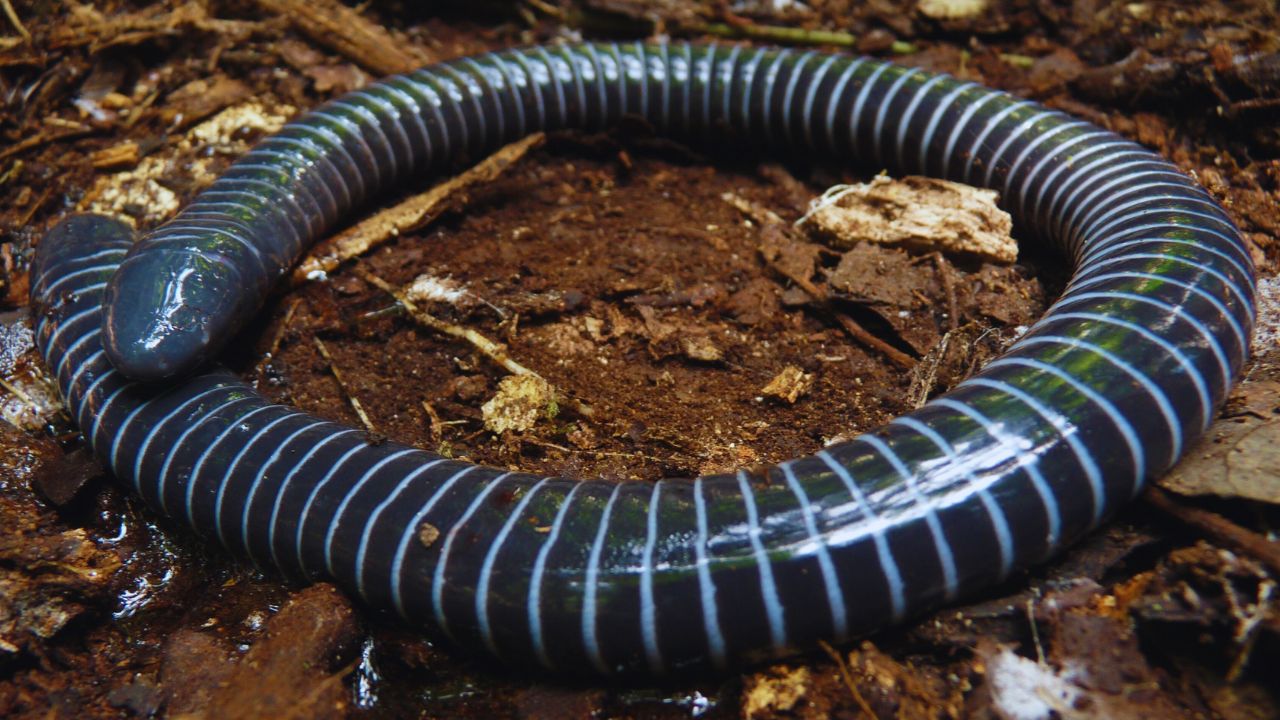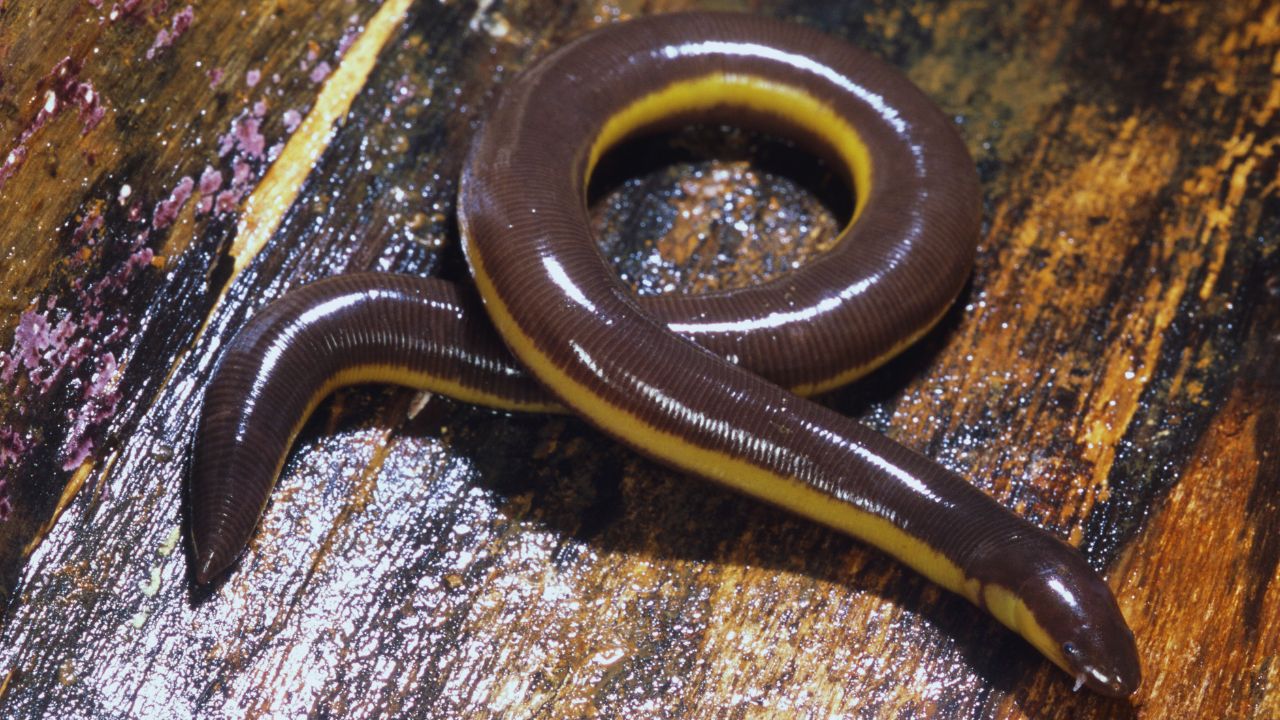The Fascinating World of Caecilians
Caecilians are intriguing, smooth-skinned, limbless amphibians, ranging from as small as three inches to as large as five feet in length. The 192 species of caecilians, native to tropical and wet regions, exhibit a wide variety of appearances. Some resemble earthworms, while others, particularly the larger species, look more like snakes. These creatures, distinguished by either short tails or none at all, are notably absent from the Americas beyond southern Mexico, with one peculiar exception: a live caecilian was discovered in a canal in South Florida in 2021. This unusual sighting was likely the result of illegal wildlife trade. Otherwise, caecilians are typically found in South America, South Asia, Southeast Asia, Africa, India, Central America, and the Seychelles. Most species are subterranean dwellers, burrowing into the ground where their lack of need for vision or hearing is evident—they have no visible ears and possess only tiny or hidden eyes beneath their skin.
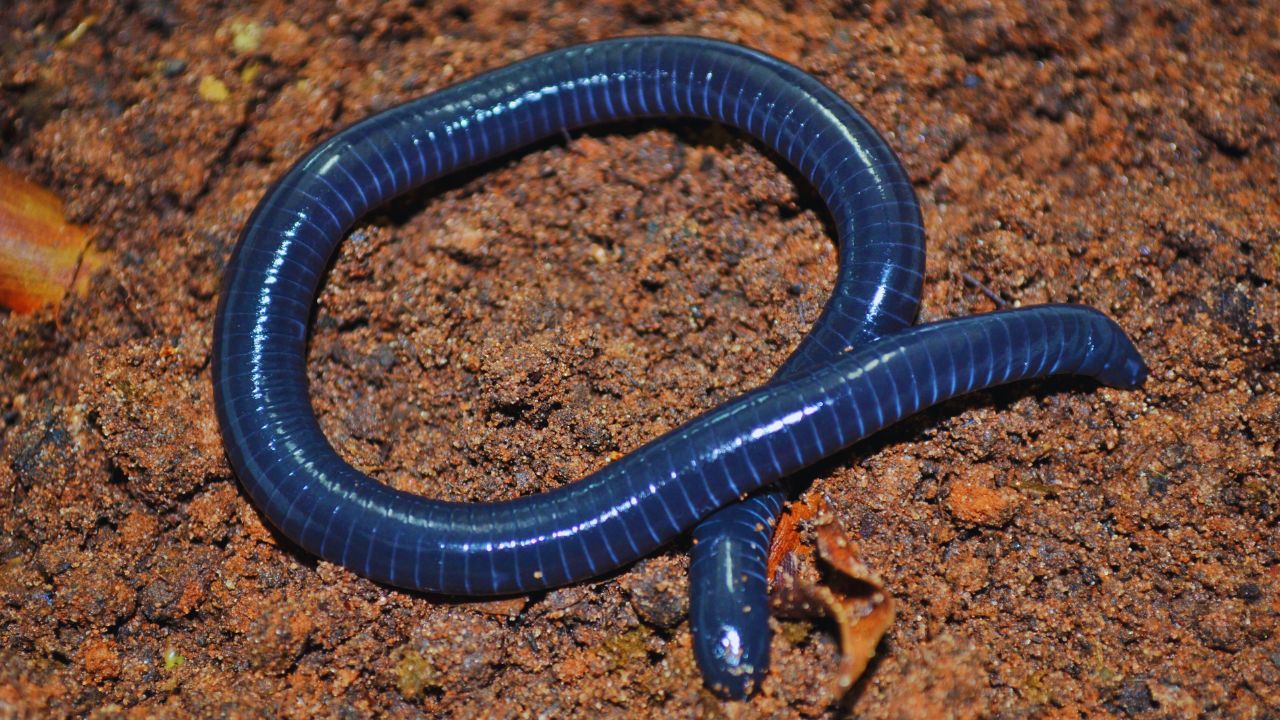
Five Remarkable Facts About Caecilians
- Some caecilians have eyes beneath their skin, while others have none at all.
- They are the only amphibians equipped with tentacles.
- The various species display a rainbow of colours.
- Their hard skulls and pointy snouts are adapted for burrowing.
- Caecilian babies engage in the unique behaviour of peeling off and consuming their mother’s skin.
Scientific Classification and Naming Debate
The term “caecilian” derives from the Latin word “caecus,” meaning blind. All modern and extinct species fall under the scientific order Gymnophiona. However, there is ongoing debate among scientists regarding this classification. Some argue that these creatures should be classified under the scientific name Apoda, which means “without feet.” Until 2011, only nine families and fewer than 200 species were recognised. The discovery of the 10th family, Chikilidae, in 2011 expanded our understanding of caecilian diversity.
| Caecilian Scientific Classification | |
|---|---|
| Kingdom | Animalia |
| Phylum | Chordata |
| Class | Amphibia |
| Order | Gymnophiona |
| Family | Caecilidae |
| Genus | Caecilia Linnaeus |
| Scientific Name | Apoda |
| Caecilian Locations | |
|---|---|
| Africa | |
| Asia | |
| Central America | |
| North America | |
| South America |
Taxonomy of Caecilians
The classification of caecilians includes several families:
- Rhinatrematidae
- Ichthyophiidae
- Scolecomorphidae
- Herpelidae
- Chikilidae
- Caeciliidae
- Typhlonectidae
- Indotyphlidae
- Siphonopidae
- Dermophiidae
Caecilian Facts
| Caecilian Facts | |
|---|---|
| Prey | termites, earthworms, insects, and other invertebrates |
| Fun Fact | Some species’ babies use their hooked or scraper-like teeth to peel off and eat their mother’s skin |
| Biggest Threat | habitat loss |
| Most Distinctive Feature | Hooked teeth in some species’ babies for peeling and eating mother’s skin |
| Litter Size | two to 60 |
| Habitat | wet and tropical |
| Predators | snakes, chickens, pigs, tenrecs, fish |
| Diet | Carnivore |
| Type | amphibian |
| Common Name | Caecilians |
| Number Of Species | 192 |
| Location | South America, South Asia, Southeast Asia, Africa, Central America, Seychelles |
Appearance and Behaviour
Caecilians, resembling either worms or snakes, vary significantly in size, from as small as three inches to nearly five feet in length. Their smooth, slippery skin is adapted to their subterranean lifestyle, covering calcite scales except in the Scolecomorphidae and Typhlonectidae families. One notable exception is Typhlonectes compressicauda of the Typhlonectidae family, which has scales on the lower part of its body. Their bodies appear segmented due to ring-shaped folds, and they have glands in their skin that secrete toxins to deter predators. Some species may even possess venomous bites.
One of the most distinctive features of caecilians is their lack of visible eyes. Instead, they have small, grey eye-like structures beneath their skin, which only allow them to differentiate between light and dark. Given their subterranean lifestyle, caecilians have little need for vision. Their hard skulls, pointed snouts, and recessed mouths facilitate their burrowing through soil and mud. Strong muscles further aid their underground navigation, while aquatic species can swim like eels and must surface to breathe. Larger aquatic species possess a fin along the rear of their bodies.
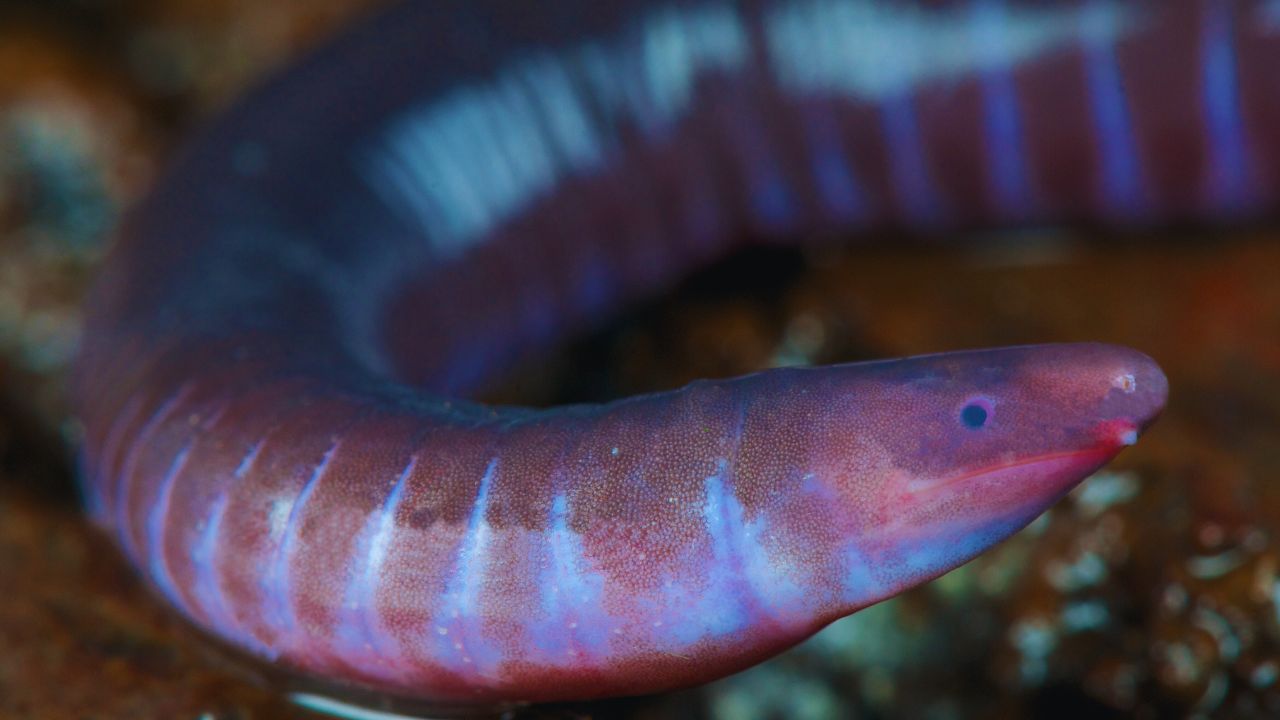
All caecilians have two tentacles located above their nostrils and beneath their eyes, which are used for environmental sensing in combination with their sense of smell. They are the only amphibians with tentacles. Although most caecilians have internal ears, some species in the family Scolecomorphidae lack any middle ear parts. Except for one species, all caecilians have lungs but can also absorb oxygen through their skin. Like snakes, many caecilians have one lung smaller than the other, an adaptation to their body shape.
The behaviour and social dynamics of caecilians remain largely unknown to scientists. It is unclear whether they are solitary or engage in any social interactions.
Habitat
Most caecilian species live underground, where they burrow, reproduce, and hunt for prey. They inhabit wet and tropical regions in Central America, South America, South Africa, Central Africa, South Asia, and Southeast Asia. Due to their subterranean lifestyle, caecilians are rarely seen in the wild. One notable exception is the giant Caecilia pachynema from Ecuador, which surfaces during rainstorms and at night. Some species can hold their breath underwater for up to 30 minutes.
Predators and Threats
Caecilians utilise their rows of sharp fangs to capture prey, which they swallow whole. They have been observed clamping onto earthworms and rolling in the dirt to subdue and drag their prey into their burrows. Some species may have venom glands behind their teeth, similar to rattlesnakes. They also possess two sets of jaw muscles, providing them with strong biting capabilities.
The diet of caecilians is not fully understood, but they have been observed consuming earthworms, crickets, and termites in captivity. The stomach contents of captured specimens have revealed various prey, including termites, earthworms, beetle pupae, molluscs, small snakes, frogs, lizards, small fish, larvae, insects, other invertebrates, and even other caecilians.
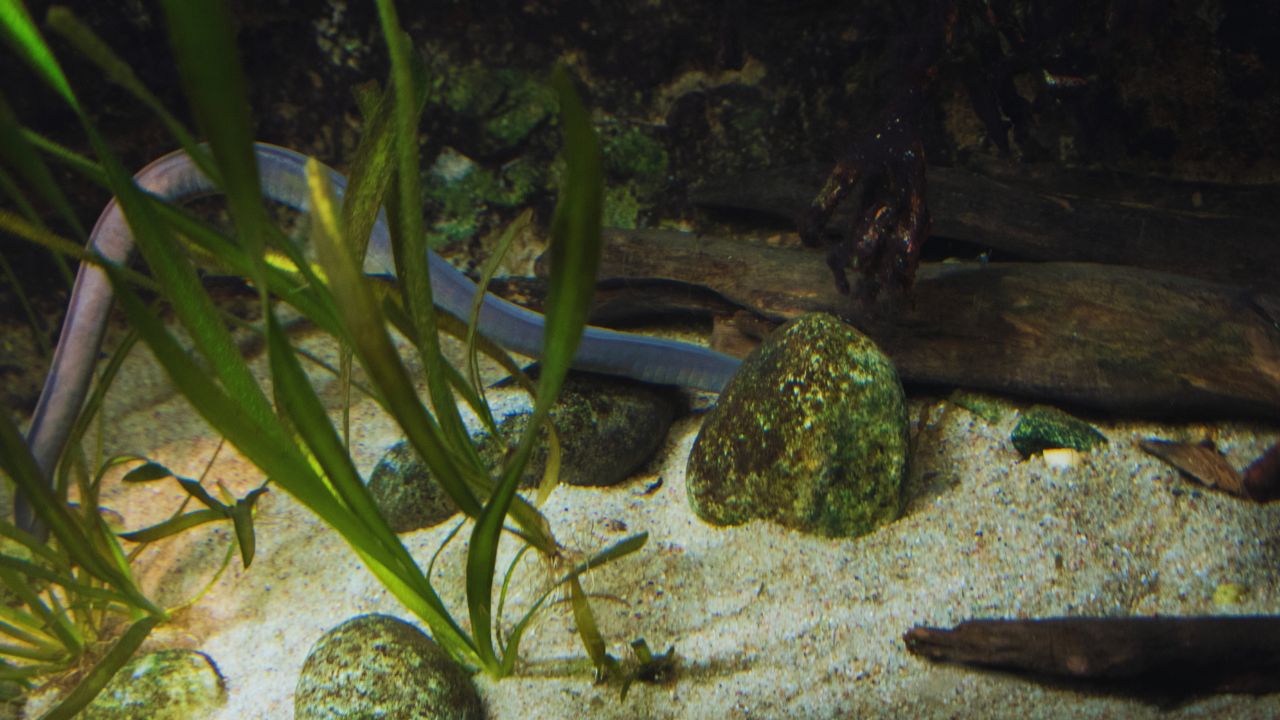
Predators of caecilians include snakes, fish, chickens, pigs, and tenrecs. However, due to their secretive lifestyle, little is known about their natural predators. Some species secrete toxins from their skin to deter potential threats.
Of the 219 known species of caecilians, the IUCN Red List currently tracks about 185 species. Most have an unknown status, with fewer than 10 listed as stable and 13 as declining. Three species are near-threatened, four are vulnerable, ten are endangered, and one, the Mount Oku Caecilian of Cameroon, is critically endangered. The primary threat to caecilians is habitat loss due to agriculture and fire.
Reproduction, Babies, and Lifespan
Caecilian reproduction involves internal insemination, with the male using a long, tube-like phallodeum to impregnate the female. Mating lasts two to three hours. Approximately 25% of caecilian species lay eggs in underground dens or water, while the remaining 75% give birth to live young. After birth or hatching, some species’ young stay with their mother for four to six weeks.
A unique aspect of caecilian reproduction is how some mothers feed their young. They grow thickened layers of skin, which the young tear away and consume using hook-like fangs. This feeding behaviour can also occur while the young are still inside the mother’s womb without causing harm to the mother. Her skin cells are plumped with fat specifically to nourish her offspring.
Some caecilians give birth to two to 25 live young, while others lay between 30 and 60 eggs. Caecilians in captivity have been known to live up to 13 years, but their lifespan in the wild remains unknown and likely varies by species.
Evolution
The evolutionary history of caecilians is a complex and evolving field of study. The first fossilised caecilian was discovered in 1972, with more fossils found in the 2000s. These fossils revealed that early caecilians had small limbs and better-developed eyes than modern species. This suggests that caecilians could have evolved from amniotes, supported by their unique reproductive traits. Ongoing discoveries continue to shape our understanding of caecilian evolution.

Population and Conservation Status
The IUCN lists over 200 caecilian species, with the majority categorised as Least Concern or Data Deficient. Thirteen species are listed as decreasing in numbers: ten as stable, three as near-threatened, four as Vulnerable, ten as Endangered, and one, the Mount Oku Caecilian, as Critically Endangered.
Notable Caecilian Species
Common Caecilians
- Caecilia abitaguae
- Caecilia albiventris
- Caecilia antioquiaensis
- Caecilia aprix
- Caecilia armata
- Caecilia atelolepis
- Caecilia attenuata
- Caecilia bokermanni
- Caecilia caribea
- Caecilia corpulenta
- Caecilia crassisquama
- Caecilia degenerata
- Caecilia disossea
- Caecilia dunni
- Caecilia epicrionopsoides
- Caecilia flavopunctata
- Caecilia goweri
- Caecilia gracilis
- Caecilia guntheri
- Caecilia inca
- Caecilia isthmica
- Caecilia leucocephala
- Caecilia macrodonta
- Caecilia marcusi
- Caecilia mertensi
- Caecilia museugoeldi
- Caecilia nigricans
- Caecilia occidentalis
- Caecilia orientalis
- Caecilia pachynema
- Caecilia perdita
- Caecilia pressula
- Caecilia pulchraserrana
- Caecilia subdermalis
- Caecilia subnigricans
- Caecilia subterminalis
- Caecilia tentaculata
- Caecilia tenuissima
- Caecilia thompsoni
- Caecilia volcani
FAQs About Caecilians
Are Caecilians Dangerous to Humans?
Generally, caecilians are not dangerous to humans. They secrete toxins to deter predators but do not pose a significant threat.
What Eats Caecilians?
Caecilians fall prey to snakes, fish, chickens, pigs, and tenrecs.
Are Caecilians Venomous?
Some caecilians may have venom glands, although this is not well-documented.
What is the Largest Caecilian?
The largest caecilian is Caecilia thompsoni, which can grow nearly five feet long.





